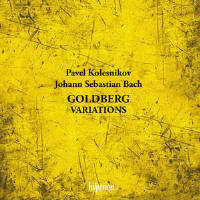Texte paru dans: / Appeared in: |
|
|
Outil de traduction (Très approximatif) |
|
|
Reviewer:
Harriet Smith In Lindsay Kemp’s fascinating feature on the Goldbergs in the October issue (2020), one of the subjects he addresses is how long different pianists wait until committing them to disc. For many artists it’s a case of decades; but Pavel Kolesnikov was prompted to learn the work after choreographer and dancer Anne Teresa De Keersmaeker asked him to collaborate with her on a new piece. Barely a year later, in December 2019, he set down this recording. A bold decision, and one in which his previous foray into Louis Couperin (also recorded on a Yamaha) and questions of Baroque style has obviously proved useful. He paces the Aria well and the following variations are full of Kolesnikov’s characteristic refinement and imaginative colour palette. I like the élan of Var 1 and the trumpets-and-drums effect in Var 4, while the Giga that is Var 7 has a limpid airiness to it. The fughetta subject of Var 10 is beautifully phrased and given real clarity, while he imbues Var 21, taken quite slowly, with an organ-like timbre, beautifully sustaining the intertwining lines. Kolesnikov talks about the Goldbergs being like ‘climbing an infinite stairway, one step at a time’, and that manifests itself in the way he emphasises the contrasts between each variation, using all the piano has to offer in the process. But that can have a downside and sometimes his ornamentation (which he tends to apply on repeats) strikes me as a touch prissy – sample Vars 1, 8 and 17 to hear what I mean. And though his fascination with bringing out unexpected lines and elements can be delightful (in Var 19, for instance), at other times it interferes with the sense of narrative – in Var 3, for example, or Var 12, which he takes at a leisurely tempo: here Perahia and Rana are more flowing and sound more instinctive. The so-called ‘Black Pearl’ (Var 25) is always a telling point in the Goldbergs and Kolesnikov takes the dynamics right down, creating a real sense of intimacy and sustaining the musical argument unerringly. I found myself impressed rather than moved by the result – Levit is more emotionally compelling here, at a spacious tempo. Kolesnikov’s is, though, far preferable to Lang Lang’s laboured reading, which, unlike Jed Distler, I found anything but heavenly. The
variations that follow also throw up issues, Var 26 sounding a tad timid
compared to Rana (delicate but with billowing phrasing), while the canon in Var
27 sounds overly fragile in Kolesnikov’s hands, especially when compared to the
rude good health of Levit. In the Quodlibet (Var 30) Rana conveys its bucolic
humour rather better than Kolesnikov, in whose hands the theme emerges out of a
wash of sound, sounding almost strident as it gains in confidence. The reprise
of the Aria is unquestionably sensitive and pianistically finessed but again I
hankered after something simpler – Perahia is just right here. So a mixed
result: I’ll be intrigued to hear how Kolesnikov’s interpretation changes over
time. |
|




